Bay Weekly’s Labor Day Parade
Summer dreams aside, we Americans are working people. In our economy, employment is a blessing and unemployment a curse. That’s so true that the unemployment rate — 8.3 percent nationally as August began — could cost Barack Obama his job as president.
Maryland’s unemployment rate of 7 percent is under the national average. But it’s high enough that a job is a job — and a good job is cause for rejoicing.
It’s not 100 percent true that we are what we do. Still, that’s one of the first questions we ask one another.
As Labor Day approaches, Bay Weekly’s inquiring reporters ask that question of neighbors erratically, if not randomly, chosen. Each answer is a story in itself; together, they tell us a lot about who, collectively, we are.
This year, we’ve hit on a lode of people who work in small businesses (including a fire department and the city of Annapolis), many within their own family. Independence and responsibility: Is that the American dream? Maybe so.
For sure, this year’s story tells us that a good job helps you do your best, for yourself and for other people.
Now, here comes the parade.
–Sandra Olivetti Martin, editor and publisher
Gracie (71), Gordon (74) and Dale (41) Bowen of Huntingtown
Neighborhood grocers
| Gordon, Gracie and Dale Bowen take a break from the family business at Bowen’s Grocery. |
At 83 years old, Bowen’s Grocery is in for the long haul.
“Walmart beat us up a little bit, but we came back,” says third-generation grocer Gordon Bowen, as he knocks on wood.
Its owners are in for the long haul, too. Except for Sunday mass, one Bowen is always on the job.
“Retirement is not in his vocabulary,” said Gracie of husband Gordon. “So do I have a choice?” She does the office work.
Gordon opens up, makes coffee, stocks the shelves and runs the register while visiting with customers and suppliers. He is Bowen’s public face. “It’s in my blood,” Gordon says.
And running strong. Son Dale runs the store’s meat department. It’s an old-fashioned, full-service butcher offering locally raised meat custom-cut for the freezer or for dinner.
A life-size fiberglass bull on the roof underscores Bowen’s dedication to quality meat. It was once stolen by a college fraternity. After 13 months, guilt got the best of one of the frat boys, who returned it with an apology.
“It’s my best advertising piece ever,” Gordon says.
A neighborhood grocery like Bowen’s is more than a place to buy meat. Kids come by after school for hand-dipped ice cream and seasonal candy. Santa comes every Christmas Eve. If the community springs a leak, Bowen’s plugs it.
“The community supports us and we support them,” Gracie says.
She might say more, but then Gordon says “Back to work!”
–Michelle Steel
Frank Cleary Sr. (79), Frank Cleary Jr. (54) and Rich Cleary (53) of Owings
Vintners
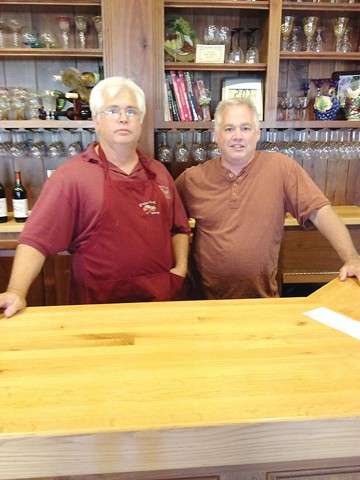 |
Friday’s Creek is a family affair. Rich is the artist, Frank Jr. is the businessman, and Frank Sr. is the man with a dream.
“We want to be a part of the local movement,” says Rich, the wine master, who is also an Anne Arundel County firefighter. “We want the wines to be an expression of Calvert County and Southern Maryland.”
Friday’s Creek wine is aged in American oak barrels from grapes seven-eighths Maryland-grown, a significant proportion in a state where grapes are hard to encourage. The family travels to local festivals and farmers markets. They partner with local businesses and nonprofits, from End Hunger in Calvert to All Saints Church.
“We are a small winery and have to have limits,” explains Frank Jr. “We want to focus our energy on supporting the local community who supports us.”
This venture grew from Frank Sr. and Rich’s home hobby. The winery is housed in an old tobacco barn. The first vines were planted in 2005. Now the Calvert winery produces 3,500 gallons of wine each year.
–Ashley Brotherton
Josh Cohen (39) of West Annapolis
Mayor of Annapolis
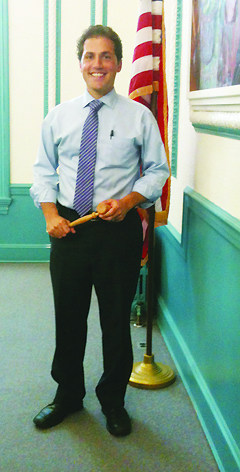 |
“I love local government, and I love Annapolis,” says Josh Cohen, who’s well into his third year in a job where he gets to make “more of a difference” than he could in his five years as an alderman.
But it’s not without its challenges, which Cohen, diplomatically, describes as also his city’s “blessings: very active, engaged and opinioned stakeholders.”
In such an environment, he says, “Building consensus and shared vision is not always the easiest thing.”
Harder still, he say, is “time management, because I know my kids are only going to be young once.”
Dreams get deferred in real life, and Cohen’s — improving his hometown’s quality of life — took a back seat to getting the city’s fiscal house in order in his first couple years as mayor.
“We were out of cash. The situation was dire,” he says.
“Stabilizing city finances, balancing the budget and putting money back in the rainy-day funds,” he says, opens the door to long-term projects.
High on that list is recovering the “amazing resource, City Dock” from “two acres of asphalt parking to an attraction in and of itself for locals and tourists.”
Getting there means resolving his biggest nuisance, Market House, “so that once it’s reopened it will be the quality centerpiece downtown.”
–Sandra Olivetti Martin
Charlie (53) and C.J. (28) Fegan of Edgewater
Taxidermists
 |
Putting pieces together like a puzzle, working 10- to 12-hour shifts, often seven days a week with no fringe benefits — except the satisfaction of perfection in a job well done — is what Charlie Fegan and son C.J. do. Taxidermy as they practice it is a fine art. Sewing heads and ears back on, working on mounts for three days without sleep before a competition and making the eyes come alive are all in a day’s work.
“It’s a natural high for me,” Charlie says.
He placed first in the world taxidermy championship in 1995. After competing with dad, C.J. got the bug. He stuffed his first rabbit at age 11. Dad’s been in business for 33 years, eight of them with C.J.
Regular customers like Anne Arundel County Sen. John Astle and Running Creek Winery owner Mike Scarborough — both African big game hunters — keep the Fegans’ business booming. As do local hunters.
Showroom and workshop total 2,400 square feet. The workshop is full of tools, chemicals, photos, mounts in progress. Fourteen full freezers fill the shed, and the backroom workshop is big enough to accommodate a giraffe.
“Rednecks are serious about their mounts,” C.J. says.
Both clients and judges look at the horns first, then the eyes.
“It’s all in the eyes,” says C.J. “We’re judged on the closest a mount looks to being alive, and that starts with the eyes.”
Charlie’s speciality is fowl. C.J. prefers deer and game heads.
Their motto: You snuff it, we stuff it. Satisfaction guaranteed.
“You get what you pay for, especially in taxidermy,” says the elder Fegan. “I want people to look at my work and say Remember Charlie? He did this.”
–Michelle Steel
Bill Doepkins (55) of Odenton
Flower farmer and arranger
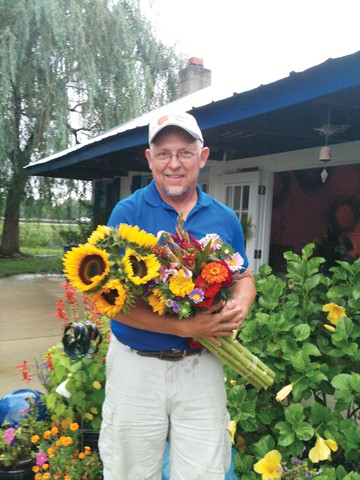 |
“I’ve been growing flowers all my life,” says Bill Doepkins, as he breaks from arranging vases of wedding flowers to explain how flowers replaced tobacco in the fields of his 220-acre, third-generation farm. “I love growing them. Dad liked them, and Grandpa — who raised crops of tomatoes and potatoes — did too.” In the 1990s — before the state paid tobacco farmers to shift crops — this third-generation farmer saw the writing on the wall. Starting with field mums, he was growing cutting flowers commercially by 2000, along with raising Red Angus beef, chickens for eggs and hay.
Doepkins sighs over the number of varieties of flowers painting his fields in brilliant stripes. “Thirty at least,” including amaranth, dahlias, sunflowers, celosias, Queen Anne’s lace and his favorite, snapdragons.
They’re cut every morning, gathered in the shed for trimming and arranged in vases and bouquets for sale on the farm and at Whole Foods Markets in Annapolis and Washington.
Come October, murals of mums bloom in his fields. Then Doepkins Farms switches to pumpkins, ending the year with a Christmas store.
“We don’t raise cats,” Doepkins says, with an expansive gesture that takes in a variety of gray, black and white cats of all ages, going about their own business. “But we need them to keep down the mice in the barns.”
–Sandra Olivetti Martin
Matt Glass (44) of St. Leonard
Brewmaster
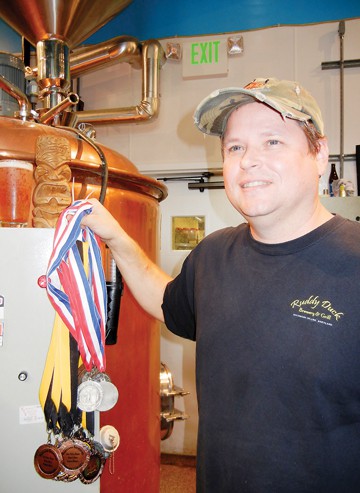 |
Matt Glass flipped his life 12 years ago, when he went from amateur brewer to pro.
At age 30, Glass — a reluctant lawyer — admitted music wasn’t his future. He took up home brewing as a hobby. That was 1986, and his timing was perfect.
“The craft beer revolution was in full swing,” says Glass, who improved his skills with correspondence courses from the Siebel Institute in Chicago.
At Ruddy Duck, he’s an award-winner.
“Every beer submitted wins a medal,” he says of his collection of awards. Prime among them is his 2010 Best in Show, Best Beer in Maryland won at the Governor’s Cup for his Helles beer, a mainstream light beer.
Glass brews five beers year-round. They’re “carved in stone.” Four others are seasonal by whim.
His current favorite is Biere Nouveau, made with sorghum, honey and quinoa but no malt or hops. The brew is his outreach to people who are gluten-intolerant.
“We hit a home-run with it,” Glass says. “It’s a low-calorie, healthy alternative for everyone.”
“With brewing, I have the freedom to create, and I love what I do. It’s a great job,” says Glass. “I haven’t punched a time clock in 12 years.”
Glass retreats to his home on the Outer Banks most Fridays through Mondays.
“It’s crunch time all week,” he says. “Then I get to relax a little.”
–Michelle Steel with Judy Angelheart
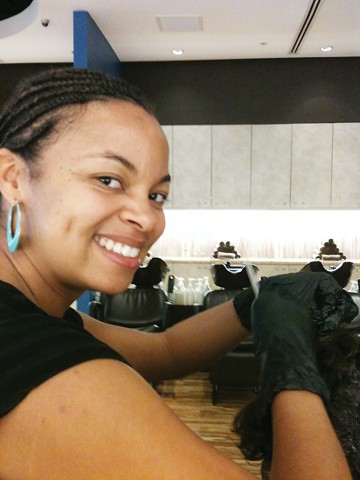 |
Kauilani Goodwyn (32) of Severn
Hair stylist and colorist
“My job is a change from what I got my degree in, chemical engineering,” says Kauilani Goodwyn. “I went to school with the idea of starting my own beauty line of naturally derived products, so Aveda is a company that’s a good fit for me. I’ve got my own little color-mixing lab here.
“My husband wasn’t so happy with my direction until he understood my earning potential. Then he thought the job was great. We have a child, and we’ve just bought a house.
“I love my job. I like working with people, and when my customers leave, they feel good about themselves and ready to take on the world,” she says.
“What other job do you know where you can run your mouth all day, get paid for it, make your customers beautiful and happy?”
–Sandra Olivetti Martin
Tom Hedges (52) of Cape St. Claire
Drywall installer
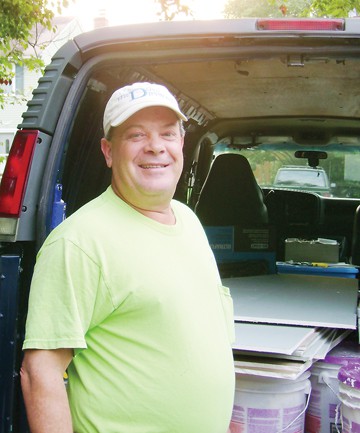 |
By 17, Tom Hedges knew “everything there was to know about drywall.”
“My dad taught me when I was young — 13, 14 years old,” he says.
He’s learned a lot more in 36 years, running his father’s business, Robert M. Hedges & Sons, with his two brothers since 1978.
Hedges Drywall handles all manner of residential and commercial work, from 13 sheets to 1,300.
“Every job is different,” he says, and that’s what he likes. He especially likes being the last in a house, handling touch-ups, and seeing how the construction came together. Today’s renaissance of rounded corners and archways is a challenge he enjoys.
The downside? “When nobody’s building.”
Before the economy tanked, Hedges had 18 employees; today, it’s seven, including a few who’ve worked with the Hedges family for more than 25 years.
Besides drywalling, there’s nothing Hedges would rather do — except “fishing and crabbing.”
–Leigh Glenn
Nehemias Geronimo Jimenez (38) of Annapolis
Owner, Geronimo Painting LLC
 |
Nehemias Geronimo Jimenez served seven years in the Mexican military, attaining the rank of captain, when he decided he wanted more independence and opportunity. Arriving in this country with a work permit 10 years ago, he found that the house painting and finish carpentry business could give him that.
Four years ago, he started the Geronimo Painting Company in Annapolis.
“I love the freedom my own company gives me,” he says. “And I love meeting new people, making new friends and just doing a good job.”
Only the high ladders Jimenez has to sometimes climb give him pause as he works toward citizenship, developing his company and enjoying his family.
–Dennis Doyle
Michael Lanier (17) of Huntingtown
Volunteer Firefighter and EMT, Huntingtown Fire Department and Rescue Squad (No. 6)
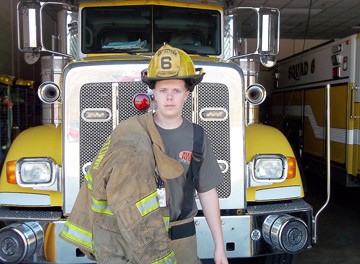 |
At 15, Michael Lanier started hanging out at Huntingtown Fire and Rescue with a volunteering neighbor.
He loved the people, the place and the work.
“I just got attached to it,” Lanier says. “Every day is a learning experience.”
After a year of training, at age 16 he was a probationer, able to go out on calls.
In a year on the job, he’s won an award for going out on more than 200 calls.
His strangest call was for a peacock stuck in a tree.
“We didn’t really save it,” Lanier admits. “We just stood there and waited, and it never came down.”
His most dramatic call was a motorcycle accident on Huntingtown Road in June. With all the sirens, lights and people, and a life hanging in the balance, “it was crazy,” the young EMT says.
Most calls at Huntingtown seek EMT response to car accidents and medical emergencies.
Calvert County is the last remaining county in Maryland where the fire department is 100 percent volunteer.
Lanier aspires to work at a paid fire department in a nearby county, Anne Arundel or Prince George’s.
“It’s very hard to get into a paid department. You have to be over-physically fit, and so many people are applying all the time,” he says. So he’s set his goal high.
–Michelle Steel
Beth Terrence (45) of Annapolis
Shaman
 |
A chance encounter with a grandparent’s reflexology book. Love of people. Fibromyalgia. These forces led Beth Terrence to become a shaman.
When Terrence could make no further physical progress on fibromyalgia, she focused on the emotions and spirit — the province of shamanic work that has been part of indigenous cultures for thousands of years.
The shamanic journey lets clients access the insights of their inner healer. The journey’s nature-based images help people feel their connections with all things.
“My work is an adventure in awareness, awakening and transformation,” says Terrence. “To witness that transformation is an incredible gift that I feel so grateful for.”
Terrence’s work is a challenge, because it’s so “experiential,” she says, finding words — hence “marketing and making the work accessible to others is an ongoing exploration.”
–Leigh Glenn
Monica Vasquez (26) of Glen Burnie
Assistant bank manager
 |
Problem solving came naturally. Skill with numbers was a talent Monica Vasquez discovered when she went to work as a new teller at the Annapolis branch of the Bank of America. Armed with those skills, in three years she worked her way up to assistant manager at the branch in Glen Burnie.
“I love problem solving,” she says. “When I first became a manager, the people I supervised were hesitant to accept me because I was so young. But when they discovered I could quickly solve any problems they had with the accounting systems or their numbers, things began going very smoothly.”
Now she’s on her way up the career ladder. “I’m attending college to get my accounting degree,” she says, “hoping to eventually move into the bank’s corporate offices.”
–Dennis Doyle
